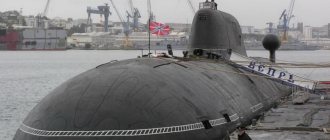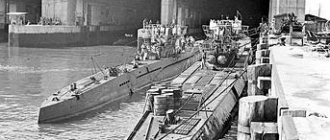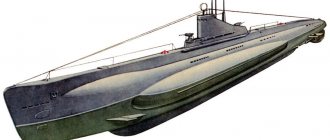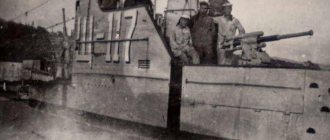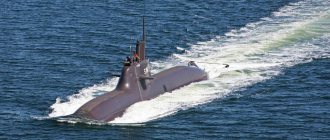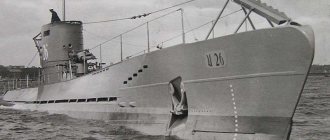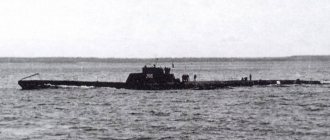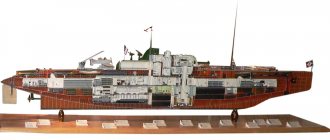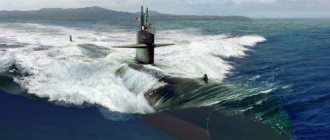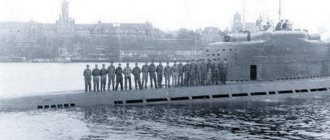How the submarines that became the most active in the Soviet Navy during the Great Patriotic War were created
Medium submarines of the "Shch" or "Pike" type were the first submarines of this type designed and built in the USSR. If the first Soviet large submarines of the “Decembrist” type were built in a very small series, then the “Pike” of various series has more than eight dozen - you must agree, an impressive number! Half of them took part in the Great Patriotic War, and three quarters of the boats that fought were lost. At the same time, the "Shch" type submarines turned out to be the best, perhaps, Soviet submarines in terms of speed and cost of construction, efficiency and survivability, which earned sincere love from the sailors.
Take the best from ours and not ours
Specialists of the Scientific and Technical Committee of the Maritime Department (NTKM) began designing the Pike in 1928, defining the main tactical and technical elements of the boat. Everyone understood that the Soviet navy needed a relatively small boat that could feel free in Baltic waters, but at the same time have serious weapons. The “Pikes” indeed received an impressive arsenal: six torpedo tubes - four bow and two stern - and a 45-mm cannon mounted on a platform in front of the wheelhouse fence.
A year later, Technical Bureau No. 4 of the Baltic Shipyard, headed by the famous submarine designer Boris Malinin, which was simultaneously designing the Decembrists, completed the development of a project for new medium-sized submarines. Since the design deadlines were very tight, the designers took the Leninets series of underwater minelayers, which had already gone into construction, as the basis for the new submarine. “Pikes” were supposed to differ from them in slightly smaller sizes and simplicity of design, since they did not have mine tubes. The Shch type project also took into account some technical solutions that were once used by the British on the L-55 boat, which Soviet sailors discovered at the bottom of the Gulf of Finland at the end of the 1920s and managed to lift.
The result was a relatively small one-and-a-half-hull submarine, which had quite decent weapons and, judging by calculations, good performance characteristics. The problem was the habitability of the boat. Since the sailors and the command of the armed forces had the opportunity to get acquainted with the project far from the initial stage, their wishes, in particular, the ability to take on board four spare torpedoes or divide the engine compartment into two, had to be taken into account later. Because of this, the conditions on the boat became cramped, and it was not possible to cope with this problem immediately.
Such different “Pikes”
The first three submarines of the new type “Pike” were laid down at the Baltic Shipyard on February 5, 1930. The head of the Red Army Naval Forces, Romuald Muklevich, who was present at the laying of the first Shchuka, emphasized that these boats open a new era in Soviet shipbuilding. The boats received their own names “Pike” (the lead ship of the series), “Perch” and “Ruff”. Another 18 days later, the “Ide” (later “Udarnik”), the fourth and last boat of the series, was laid down in Nizhny Novgorod. Since during its construction, 2.5 million rubles were also used, collected on the initiative of the Komsomol Central Committee by Komsomol members throughout the country, this boat was renamed “Komsomolets” while still on the slipway.
The first series of Pike-class submarines was called “Series III”. This is not surprising: at that time the serial numbering was continuous, and series I was called “Decembrists”, and series II was called “Leninists”. That is why subsequent series of boats of the “Shch” type also did not have sequential numbers, but with “jumps”. Thus, the next series of 12 submarines, laid down at three Leningrad shipbuilding enterprises - the Baltic Shipyard, the Marti Shipyard and the Northern Shipyard, was called the V series, since the IV series was called the Pravda-class submarines.
The “Fives” were intended for the recreated Naval Forces of the Far East, the future Pacific Fleet. This is where the relatively small size of the new submarines comes in handy. They were laid down and began to be built at factories in the European part of the USSR - in Leningrad and Nizhny Novgorod (later Gorky), and then unassembled were sent by rail to Vladivostok and Khabarovsk. There, the submarines were fully assembled, launched, retrofitted, and commissioned. All this was done at an accelerated pace. The decision to build series V boats was made in December 1931, and they were supposed to be presented for testing by November 1, 1932. It helped that the series was not much different from the previous one, although the wheelhouse had a different, more streamlined shape, a second 45-mm cannon appeared behind it, and the durable hull was divided not into six, but into seven compartments, which increased unsinkability. On the other hand, the “fives” began to be built without yet having experience in completing the construction of series III boats, which is why there were many defects in their design.
The V series was followed by the V-bis series of 13 submarines built for the Pacific, Baltic and Black Seas. Baltic and Black Sea boats left Leningrad and Gorky along inland waterways, while Pacific boats still left by rail. This series differed slightly from the previous one, since all the changes were mainly limited to eliminating previously discovered shortcomings and design defects. And then they began to build boats of the V-bis-2 series, which included 13 submarines, also slightly different from their predecessors.
The largest series of submarines of the “Pike” type is 32 submarines! - became the X series. These boats received very characteristic new type of wheelhouse fencing (the so-called “limousine”), which was supposed to increase their underwater speed. In reality, this almost did not happen, and when on the surface the bridge was very flooded. This drawback was eliminated only on the “Pike” X-bis series, which were given the usual shape of the wheelhouse fencing. The boats of this series were laid down before the war, and were completed after it began, and only nine “Pikes” were completed; two boats were dismantled on the slipway, and the construction of two more was abandoned.
The main armament of all submarines of the "Shch" type - six torpedo tubes - remained unchanged throughout the entire construction period and for all series. But the artillery could vary. The first "Pikes" had only one 45-mm gun on the forecastle, the V series boats had one on the forecastle and on the poop, and there were options for installing 37-mm anti-aircraft guns, DShK heavy machine guns, and even attempts to install 76-mm guns on the boats!
Operations Regenbogen and Deadlight
Legends about the fate of hundreds of German submarines continue to circulate today. In myths and free interpretations, they exported the Nazi leadership to South America, and from it - minerals, as if repeating the policy of the conquistadors. In reports of varying degrees of reliability, submarines of the Third Reich continue to be found sunk in Antarctica, Taimyr and off the coast of Crimea.
In fact, the fate of Hitler's submarine fleet was the same as that of the rest of the army - it was defeated. Most of the boats were lost in battle; the remaining ones were subjected to two interesting operations. The first is called “Regenbogen”. It is no coincidence that this word sounds so German - the operation was planned and implemented by the Nazis themselves. At the end of April 1945, an imminent surrender became obvious, and Doenitz ordered the crews of all German ships to scuttle them to preserve the honor of the fleet. The order was carried out - 238 submarines went to the bottom. By the way, Regenbogen is translated from German as “rainbow”.
The Allies also did not spare Hitler’s captured submarines. At the end of 1945 - beginning of 1946, they carried out Operation Deadlight, during which 121 captured submarines were sunk. Another 33 submarines remained with the victorious countries for testing, replenishing their own fleet and creating museums.
Karl Doenitz survived the Nuremberg trials, served 10 years and died in 1980. He spent the rest of his life in obscurity, but wrote three books - two about his life and one about submarine warfare tactics.
Feats in peacetime and war
"Pikes" became the most numerous pre-war submarines of the Soviet navy. It is not surprising that these particular boats turned into a kind of “floating desks” for the command and rank and file of Soviet submariners. In accordance with the pre-war doctrine, the Navy of the Soviet Union was supposed to be mainly a coastal force intended to fight the enemy primarily in its own territorial waters. A big role in this was given to submarines, which required not only building them at incredible speed, but also training their crews at the same speed.
That is why almost all the famous pre-war records related to autonomous navigation were achieved by the Shchuka. The first 40-day voyage in January-February 1936 was made by the Far Eastern Shch-117. Then there were the voyages of Shch-122 (lasting 52 days), Shch-123 (75 days), and Shch-113 achieved an absolutely incredible result, spending 102 days in autonomous navigation - from September 14 to December 25, 1936. In 1940, the submarine Shch-423 became the first submarine in the world to navigate the Northern Sea Route: on August 5, the boat set out from Polyarny, and on October 17, it arrived in Vladivostok, having covered 7,227 nautical miles, including 682 miles in ice .
All these experiments and records were very useful to Soviet sailors during the Great Patriotic War. Numerous "Pikes", quite well armed and capable of long voyages, became the main striking force of the submarine fleet of the Soviet Union. They account for a third of the total tonnage of the enemy fleet destroyed by Soviet submariners: according to various sources, from 79,855 to 233,488 gross register tons. At the same time, five boats of the Baltic Fleet, three of the Northern and two of the Black Sea were awarded the Order of the Red Banner, two Baltic, two of the Black Sea and one of the North Sea became Guards, and the Shch-402 submarine of the Northern Fleet became a Guards Red Banner ship.
For these successes, the submariners who fought on the Pike had to pay a considerable price. Three of the four submarines of this type that fought did not return to their native harbors, sank to the bottom forever. And the “Pikes”, which managed to survive the formidable war years, continued to serve in the navy until the end of the 1950s. Of course, most of them served out their term in the role not of combat submarines, but of floating charging or training stations. But there were also those that stood guard over the country’s maritime borders until the very end, for example, the Pacific Shch-137, which entered service in 1941 and left service only in 1957.
Great construction
Before the start of the war, that is, until September 1, 1939, the Third Reich had 57 submarines. The country received permission to build submarines only in 1935. Before this, the Treaty of Versailles was in force, one of the conditions of which was a ban on Germany making submarines. However, the Nazi regime gradually regained its position, and one of these diplomatic successes was the conclusion of the Anglo-German Naval Agreement. According to it, submarines were recognized as obsolete weapons, and the bans on their production disappeared.
In June 1939, the German submarine fleet was headed by Karl Doenitz, an outstanding military specialist who developed the concept of submarine warfare. He had enormous power at his disposal. During World War II, a new submarine appeared in the Kriegsmarine every 2 days.
